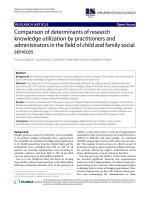The inter relationship between strategy, planning, plan in the field of science and technology
Bạn đang xem bản rút gọn của tài liệu. Xem và tải ngay bản đầy đủ của tài liệu tại đây (229.99 KB, 17 trang )
JSTPM Vol 2, No 4, 2013
53
THE INTER-RELATIONSHIP BETWEEN STRATEGY,
PLANNING, PLAN IN THE FIELD OF
SCIENCE AND TECHNOLOGY
M.Sc Nguyen Viet Hoa
National Institute for Science and Technology Policy and Strategy Studies
Abstract
Science and technology (S&T) strategy, planning, plan are always inter-related in respect
of legislation, interaction, dependency and complementary to each other. They are
intentionally formulated based on planned ideas. During the development of S&T policy,
policy-makers always try to create a sustainable relationship among them, but to do that,
there exist many difficulties encountered in reality. In this article, the author focused on
research concerning theoretical bases, characteristics and rules of the relationship
between S&T strategy, planning, plan to draw out from there a meaningful methodology.
Keywords: Science and Technology Strategy; Science and Technology Planning; Science
and Technology Plan.
Code: 13090303
1. Theoretical bases of the relationship between science and technology
strategy, planning, plan
1.1. Theoretical bases
The term "strategy" has so far been confirmed by many studies that it
derived from military field and it means the way how to win in a war. The
term was created in the ancient Greece and then be applied in many fields
and now is still used and continuously further developed. The terms
"planning" and "plan" were launched later than “strategy” term but they
have been utilized in many areas/sectors. To date, the question of when all
of these three terms were first applied in the field of S&T is still
controversial, many opinions believed that they appeared in the modern
scientific and technological revolution started in mid-forties of the XX
century. Presently, with the contemporary scientific and technological
revolution in XXI century, the concept of strategy, planning, plan in the
field of S&T has experienced a lot of changes.
Theoretically, based mainly on the innovation theory in strategy
development, many foreign scholars recognized the following persons as
54
The inter-relationship between strategy, planning, plan…
first scientists who laid the foundation for change of thinking on S&T
strategy, namely Freeman (1987), Lundvall (1992), Nelson (1993), Edquist
(1997), when they began introducing the concept of innovation system (IS)
in the 80th - 90th. This concept pointed out the role of each elements having
strong influence in the system as well as the role of institutional tools in
providing a guiding framework for respective interactive relations.
Following the innovation system concept, many scientists continue to
conduct deeper studies and put forward the concept of science, technology
and innovation (STI). This new concept is now commonly known as STI
system and used in the development of S&T strategy.
S&T planning is now undertaken in many countries, but there are not much
studies on the concept and method of planning. In 2008, Robert J.Lempert
and James L.Bonomo proposed two new methods for S&T planning, i.e,
HyperForum, an enabling environment for collaborative groups working on
global networks, is carefully conducted with rich information, on-line
environment; Exploratory Modeling, a new approach based on the
deployment and use of information technology, for creating systems,
quantitative comparisons of alternative policy decisions without relying on
imperfect future predictions.
It was observed that research works of experts in the field of innovation had
not clearly defined the concept of S&T strategy, planning, plan. They
mainly offered new approaches to guide general renovation of S&T policy.
Furthermore, conducted studies also had many limitations as there not
considered the relationship between S&T strategy, planning, plan.
In the diversified development of the innovation theory, some international
organizations (OECD, APEC, World Bank) launched in the 80-90 decade of
last century, various criteria to assess the development of knowledge
economy, known as Knowledge Economy Index (KEI), to serve as a basis to
adjust development strategy, policy. The KEI criteria provided an
active/useful tool for the formulation, adjustment of socio-economic and
S&T strategy, planning and plans. In 2010, OECD introduced the concept of
Innovation Strategy, in which it clearly indicated specific contents and
action programs to help government of member and non-member countries
to use it as an action oriented framework in the context of global economic
crisis.
In 2010, UNIDO provided Policy Advisory Assistance to Vietnam for the
development of Science, Technology and Innovation (STI) Strategy, period
2011-2020, and the implementation of High Tech Law. In the advisory
framework, UNIDO used the term STI and provided various research
methods, e.g, SWOT - Analysis of strengths, weaknesses, opportunities and
JSTPM Vol 2, No 4, 2013
55
threats; Context scenarios; Success scenarios; Delphi survey; Key
technologies and Key technology innovation systems; Future Vision;
Roadmap - a sequence of steps or events needed to perform a scenario.
Based on STI Strategy, S&T strategy is determined for respective elements
of the innovation system. Although the scenario given by UNIDO was a
fairly broad framework, it did not make a clear concept nor point out the
relationship between S&T strategy, planning, plan specifically for Vietnam,
therefore the technical assistance and policy advice given by UNIDO for the
development of Vietnam S&T strategy 2011 - 2020 was not so efficient as
expected.
1.2. Concept of relationship between S&T strategy, planning, plan
1.2.1. The concept of relationship
To date, many scientists have still relied on the two principles of materialist
dialectics of the Marxist - Leninist philosophy when considering a subject.
F. Engels defined: Dialectics is nothing more than a science studying on
common rules of the motion and development of nature, human society and
thinking” [1] and "dialectical method is a method of looking at objects and
their reflections in human thinking, mainly through their interrelation in the
chain of their connection, movement, emergence and disappearance” [2].
Theory of common relationship is a theoretical principle used to take into
consideration of objects or different sides of an object or objective
phenomena in the universe, which are mutually binding, influencing,
interacting and existing in their relationship.
Theory of development is a theoretical principle used to consider objects,
objective phenomena in a dynamic context by putting them in a continuous
evolution, development process (moving from low to high level, from
simplicity to complexity, from less to more perfect things).
1.2.2. Concept of S&T strategy, planning, plan
Concept of S&T strategy
So far, there exist many concepts of S&T strategy. In brief, some key
concepts focus on characteristics, position and role of the strategy, as
follows:
- S&T strategy possesses systematic, principle, standard character, it has a
defined role of serving socio-economic development: “S&T
Development Strategy provides norms, rules and regulations to regulate
behavior in S&T activities. It is in nature a comprehensive, long-term
56
The inter-relationship between strategy, planning, plan…
document formulated for a nation or a region in service of performing
socio-economic development tasks and meeting the need of S&T
development itself. The strategy includes some basic items such as key
directives, goals/objectives, priorities and major measures for the strategy
implementation” [3].
- S&T development strategy has a breakthrough character, it steers the
socio-economic development: S&T development strategy is a system of
viewpoints, guidelines and major measures, in nature it is basic and
breakthrough document viable for a period of 15-30 years to ensure the
achievement of the desired goals of S&T development [17].
- S&T strategy is not merely for service of or leading the socio-economic
development, it still has bigger and more special tasks, i.e, changing the
position of the nation: S&T development strategy is, in fact, the strategic,
tactic in scientific and technological development; it is the crucial
principle for actions, it sets out timeline and itinerary for development as
well as provides a common platform for policy decision making,
elaboration of plans and tasks of S&T development [11]. In some special
cases where S&T strategy is not adopted as strategical, tactical tool, some
countries still utilize it for technology copy, decoding, planning of action
in a systematic way for the benefit of their nation.
Academically it can say the concept of S&T strategy already exists,
however, in reality not much attention has been given to the practical
identification of the strategy. In this study: S&T Strategy is identified as a
legal document (called in short, S&T Document) which has been formulated
based on a system of viewpoints, a set of specific goals, directions, tasks,
solutions, implementation arrangements with detailed objects and scope of
application, methods, principles, long-term implementation and it is
decisive for the development of S&T. The promulgating authority of the
strategy is Prime Minister under his Decision, the timespan of effectiveness
may be 10 years, 20 years, 30 years or longer, and the legal basis for issuing
the strategy is the prevailing Law on Promulgation of Legal Documents.
Concept of S&T Planning
S&T Planning receives much attention by developed and developing
countries, particularly newly developed countries in Asia like Republic of
Korea, China, Japan, when developing S&T policies. There exist many
different concepts on S&T planning, such as:
- Macro concept: S&T development planning is the master plan of
directive character for a relatively long-term plan of S&T development, it
reflects the need of a long-term plan drawn out by the State for a given
JSTPM Vol 2, No 4, 2013
57
period of time based on the need of socio-economic development of the
nation, it is the overall layout/arrangement for the future development of
S&T [3].
- Specific concept: Planning of S&T development may be summarized as
follows [13]:
Planning of S&T development must be a basis and in practical service
for the objectives of S&T development.
Planning of S&T development must balance the needs for building
and developing indigenous S&T capacity of the country, work out the
implementation roadmap with concrete steps to achieve the set out
objectives of S&T and socio-economic development.
Planning of S&T development is, after all, the final feasibility study to
achieve the socio-economic and S&T development goals in a most
cost-effective manner.
- Concept based on the relationship between S&T planning and S&T
strategy: Planning and implementation of S&T development plan is in
fact, the implementation of strategy, directives, policies and objectives of
S&T development of each country. It serves as a basis for making annual
S&T plans. As the plan period is relatively long, the change of scientific
and technological development is very rapid, and there are so many
unforeseen factors, it can, therefore, only suggest tentative preliminary
contents for later development, in the principle of making common
assumptions to achieve strategic goals" [11].
Although the concept of S&T planning is somewhat different, it is basically
the same as per definition in administrative planning hierarchy [3]:
- State-level planning: it includes the master plan of different specialized
sectors, public planning, the need of inclusion into key S&T categories of
national planning, namely: (a) S&T general, crucial issues which can be
the locomotive to pull the whole setting, interdisciplinary, inter-regional
tasks; (b) Some specialized fields that have the ability to bring about
major scientific and technological breakthroughs.
- Sector and regional planning: includes the overall objectives and S&T
development directions of a sector or region for a relatively long period,
the overall estimation, arrangement and orientation for S&T development
of the country as a whole in combination with the characteristics and
requirements of each sector/region. The national scientific and
technological planning is the basis for sector and regional planning.
The inter-relationship between strategy, planning, plan…
58
- Grassroots-level planning: is the planning to develop S&T at grassroots
level such as research institutions, universities, colleges and enterprises,
etc. based on the goals and needs of state, sector or regional planning,
and must be market demand oriented in consideration with the
development direction and specific conditions of their institutions. It can
say that grassroots institutions is the place where the national, sector,
regional is materialized.
In the present context where there exists cross-cutting and interdisciplinary
effect, the S&T planning process often relies on socio-economic
development plans. It is therefore S&T planning is associated with the
economic spatial distribution (economic zones) to arrange a network of
S&T institutions, S&T parks/clusters, S&T enterprises, S&T models. In
addition, the present issue of climate change, global economic crisis places
significant impacts on socio-economic and S&T development plans. So
when realizing S&T planning it needs to take into account the issues of
environment, climate and investment resources for S&T.
Concept of S&T Plan
Compared with the concept of S&T strategy, planning, the concept of S&T
plan is more specifically explained:
- Plan is a part of S&T Planning: The plan is a specific part of the
planning, it is the action arrangement to achieve setforth objectives. It
usually consists of objectives, measures to ensure necessary conditions/
resources such as: human, financial and material, information
resources… are available to achieve the objectives. The main objective of
the S&T plan is to implement the S&T development planning [3]. S&T
plans shall work out every specific steps of the S&T development
planning of a nation in a five-year period or longer. S&T plan is a set of
directions, objectives and implementable measures to achieve the
intentions, policies and strategies for scientific and technological
development of a country. This is a group of objectives and major
solutions at the country or regional level to obtain those objectives [17].
Plan classification by time frame of activity [3].
Long-term plan, it is called perspective planning of S&T development
(for 10 years or more), and is the strategic plan having decisive role in
setting the key strategic directions and basic contents for medium term
plans, and it is the foundation for developing medium-term plans.
JSTPM Vol 2, No 4, 2013
59
Medium-term plan (5 years), is the basic form of plan management,
the concretization of planning and the basis for making short-term
plans.
Short-term plan, is the annual action plan of scientific and
technological development to materialize specific tasks of the
medium-and long-term plans.
- S&T plan is an integrated part of socio-economic development plan, but
at the same time it should pay attention to the particularity of S&T (in the
identification of S&T development trends). It is the main tool for the
State to implement and manage S&T activities [17].
Requirements for the formulation of S&T plans:
Ensured consistency with socio-economic development plans and
objectives of S&T development (technology of novelty, breakthrough
character).
The objectives of annual plan are integrated with the 5-year plan.
The formulation of S&T plans is linked with the actual demand of
production and life, appropriate with economic development potential,
has positive impacts on the socio-economic development indicators
which are determined by a throughout cycle.
Market
Scientific
Research
Techno
developm
ent
Source: Study of authors
Producti
on
Market
Figure 1. Requirements
formulation of S&T plans
for
the
1.3. Practical and legal basis
Experience of the countries in the region such as Republic of Korea, Japan,
China shows that the basis for formulating S&T strategies, planning and
plans relies a lot on environmental and institutional context.
1.3.1. Experience of South Korea
The S&T plan came into life earlier than S&T strategy, planning, it was
included in an Article of Law on Key Plan for S&T development, and then
it was specified in Article 2 of Art 1992 regarding implementation of the
Law on Korean S&T development. The comprehensive plan for S&T
development consists of two main parts: Plan for the promotion of S&T
60
The inter-relationship between strategy, planning, plan…
Application and plan for business, development of research stages S&T
Training [2].
In 1999, the Korean government issued the 1999 Action Programme and
Vision to 2025 for S&T development based on the Frame Law on S&T.
Vision 2025 included 40 tasks and 20 proposals which had been designed to
guide the transition of the economy to higher level of development and
successful through the development of S&T.
The relationship based on the provisions of the Strategy of Action and
Vision 2025 to formulate the Vision 2025 action plan [5]: In the short term,
the government shall be preparing conditions for a future knowledge
society, in the long term, the country’s S&T must play an important role in
the global community. Republic of Korea strives to become, by 2015, the
scientific research center of the Asia - Pacific region. By 2025, the country
shall join the rank of industrialized countries. The goal up to 2025, Korea
shall be placed in the top 7 on technological competitiveness capacity. The
promising technologies in the future were: Information Technology;
Biotechnology, Environment technology, Energy technology, Mechatronics and Systems technology, and Materials and Processing technology.
Basic plans of S&T: Based on the Frame Law on S&T in 1999, the
government has developed the following plans: First S&T five year Plan
(2001-2006); Basic Plan of S&T (2003-2007); Basic Plan of S&T (20082012) - Initiative 577, which is the center of the current S&T strategy and
policy of Republic of Korea.
1.3.2. Experience of China
In 1993, the VIII Legislative of the National Assembly of the People's
Republic of China adopted the Law on Scientific and Technical Progress of
the People's Republic of China. Chapter I, Article 7 indicates: Government
shall make decision on planning for scientific and technical development,
identify major categories of S&T, those are closely related to S&T, ensure
smooth coordination between scientific and technical progress and
economic and social development. The government shall decide upon major
S&T planning and policies, major categories of S&T, those large categories
closely related to S&T, receive opinions of scientific and technical workers,
practice the principles of making decisions scientifically [2].
Entering the new century with increasingly vigorous integration and
international competition, it was required that the planning of S&T
development be clearly placed in the global and domestic context: Urgent
need for scientific and technological development in the building a
JSTPM Vol 2, No 4, 2013
61
comprehensive middle-class society following new-type industrialization
was the basic starting point for the formulation of the S&T development
plan in new era; Changes in the world economic, politic situation make
higher requirements for scientific and technological development; New
development trends makes China to stem from top strategy to provide
arrangements of predictive nature; Institutions of socialist market economy
requires new design and layout for the entire national innovation system.
The policy support tools to implement the 15 year S&T development plan
[7] including: tax policies; funding and financial policies, government
procurement policies.
1.3.3. Experience of Japan
Japan always desires to be the world leader in S&T, share with the world
their experiences and achievements in S&T. The Basic Law of S&T came
into effect in 1995, this is the legal document for the State to pursue the goal
of making the country become a “Science, Technology and Innovation
based Nation”, whereby the State shall be responsible for longer-term
investment and at higher level in S&T.
From 1996 to present, Japan has experienced 4 times of formulating Japan's
S&T Basic Plans, namely: The First Plan (1996-2000), the Second Plan
(2001-2005), the Third Plan (2006-2010), and the Fourth Plan (2011-2015).
In the initial stage of S&T development, the S&T Plan had been formulated
before the Strategy of S&T came into life, later on Japan’s S&T
development experienced many changes, many conditions that made Japan
build different process of S&T development. To date, the country’s S&T
vision - strategic orientations - plans are interactive, inter-connected and
mutually complementary.
- Vision 2050: In 2005, the National Scientific Council of Japan issued the
“Japan Vision 2050” and pointed out that by 2050, Japan will became a
high dignity nation (all values almost reach the highest) and the trust of
Asia be created [6]. The structure of the Vision includes major
components as follows: Overview on characteristics of Japan and the
world's in 20th Century; Challenges that the world, Japan and Asia must
confront in 21st century; Mission, goals to be obtained, S&T as well as
education and training strategy and policy of Japan. Time frame for
implementation consists of 3 phases with 5 year plan each for
implementation. Principles of S&T policies in the plan are to ensure the
certainty and stability of the economy and environment.
- Strategic Orientation for Innovation of Japan up to 2025: The roadmap
of technological innovation strategies consists of 3 layers: (1) Project to
The inter-relationship between strategy, planning, plan…
62
accelerate the transfer of technological results to society by reviewing the
whole process, from basic research, research and development,
technology transfer to society; (2) To promote oriented strategic and
specialized research and development on a selective and concentrative
basis; (3) Highly Innovative Basic research and activities creating seeds
for innovation. The roadmap for research and development is aimed at
materializing the 5 social images of Japan by 2025, i.e,: (1) A society that
all people live healthy throughout their life; (2) A society that is safe and
insured; (3) A society which can grasp the diversity of life; (4) A society
that participates in solving global problems; (5) A society that is open to
the world.
- Basic S&T Plan: In the 4th S&T Basic Plan for 5 years starting from
2011, Japan considered that S&T policy played the role of reviving the
society, solving the problems that mankind society is facing. On the other
hand, Japan affirmed that S&T policy had a basic position in the National
Strategy. It had a close relationship with other important policies,... The
4th Basic Plan had to assess the achievements and drawbacks during the
implementation of the 3rd Basic Plan, through a further improvement of
policies and strengthened S&T, technological innovation, new structures
of strategy development to create more new value for the country [12].
2. Nature of S&T strategy, planning and plan
2.1. Objectivity
S&T strategy, planning, plan are studied and formulated based on the
objective requirements of practice, so they must be associated with the
context/situation, current status of socio-economic and S&T development.
According to Prof. Leslie Pal, policies are developed in a specific
institutional context. In order to be able to track and monitor policies as well
as manage their progress, it is important to understand the context where the
policy has been developed, as well as the process of the policy development
to see how it took place and why it is repeated. This view is supported many
experts because this is of high efficiency for S&T policy makers.
In 2007, Andrew Green and Sara Bennett1 indicated that understanding of
the policy context is extremely important because "Policy development
cannot be apart from political - economic - social elements. All of these
elements have influencing effect on the policy at all levels: global, national
1
Andrew Green and Sara Bennett. (2007) Sound choices: enhancing capacity for evidence-informed health policy.
/>
JSTPM Vol 2, No 4, 2013
63
and regional. Clear understanding on global trends helps increased
recognition of the extent to which the nations are interdependent”.
Thus, experts suggest that policy makers need to pay attention to the context
of policy development with a view to issuing not only appropriate policies
to the reality, actual policy tracking, monitoring works but also avoiding the
separation of policy with practical life of the country and the world.
2.2. Popularity
S&T strategy, planning, plan basically are not isolated. This is a set of interconnected documents that create a unified platform to build a
system/structure. The system, structure of S&T strategy, planning, plan is a
kind of open, interactive, interdependent, mutual binding and
complementary system for the following reasons:
- S&T strategy is the back born for making S&T policy, it has a major
impact on the development of science.
- S&T planning, plan is an important step in S&T management.
- S&T planning, plan is an important integral part of the national economic
development planning.
- S&T planning, plan is an important assurance to promote the inspiration
and proactiveness of S&T personnel and raise their scientific and
technological level.
- S&T planning, plan is a means to link the national economic
development with scientific and technological development in line with
market oriented planning.
2.3. Diversity of S&T strategy, planning, plan
- Scientific aspect: S&T strategy, planning, plan must be consistent with
common law of S&T, socio-economic development and it should be
formulated from an overall, long-term vision, based on the results of
S&T surveys and forecasts.
- Systematic aspect: S&T planning has the task of making unified
arrangements, determining right directions, priorities, key development
objectives, specific conditions and solutions for implementation.
- Coordinating aspect: it primarily reflects the major important categories
in the planning process. To do that, it is necessary to have the
cooperation and involvement of many institutions, many new scientific
disciplines.
64
The inter-relationship between strategy, planning, plan…
- Adaptation aspect: S&T planning, plan must be adaptive to major
preconditions of the state-own economic base, S&T development
environment and international context.
- Legal aspect: S&T planning, plan at national, regional or sector level are
all for S&T development objectives, increased level of scientific and
technological progress and timely and right application of S&T results,
and at the same time it must clearly reflect the development level and
economic efficiency of the productive forces based on of scientific and
technological progress.
S&T strategy, planning, plan can be developed at different time, content,
requirement, but always are associated with certain historical conditions.
2.4. The difference between S&T strategy, planning, plan
S&T Development Strategy is not the same as the normal S&T development
planning. S&T development planning needs to reflect the content of the
S&T development strategy but cannot be identical to the strategy itself.
Planning requires a specific timeline, there is a lot of contents need to be
quantified towards achieving specific outputs. In the meantime, S&T
Development Strategy primarily addresses to broad policy issues of
orientation, comprehensive and long-term, decisive nature.
Planning and plan are two separate concepts on the one hand, but have close
interrelation, on the other. S&T planning is a document of guiding,
forecasting nature of the objective, basically it is an indicative planning
document. Planning and plan are together making plans and planning
flexible, consistent with practical requirements. Planning decides upon tasks
and content of plan and is as a basis for making plans.
The plan must be based on S&T planning, it identifies specific task items,
completion date, workload, quantity of resources to be used, applicable
policies for implementation… In brief, planning is the definition of strategic
objectives of S&T while plan is the specific arrangement of tactical actions.
Compared to S&T planning, the characteristics of S&T plan are of relatively
short-term, clearer goals. In respect of implementation modality, it is more
specific with the annual plan and tasks assigned to direct dependent
relationship.
For strategy, it is required to ensure the "feasibility" and the "reasonability"
while the plan must be "effective” [15].
3. Rules of the relationship between S&T strategy, planning, plan
JSTPM Vol 2, No 4, 2013
65
3.1. Repetitive, stable relationship, and creation of interactive model
The inside relation between S&T strategy, planning, plan is a dialectical
relation, S&T strategy is a premise for S&T planning to be closely
connected with S&T plan. The relationship between S&T strategy,
planning, plan is inseparable and interdependent. Because "a strategy should
be understood as an "overall package" which includes long-term goals, the
means and resources to be used in accordance with the arrangement of
planning, medium-term and short-term plans under different programs and
projects in order to achieve already identified long-term goals” [10, p.13].
S&T development strategy provides a basis for determining issues in S&T
development planning. The basic role of S&T development strategy in
planning of S&T development is first to provide important bases, namely:
strategic views, objectives and orientations, solutions; objects and scope of
application; periods in S&T development strategy, and the level of funding.
The contents of the S&T development Strategy should be further specified
in the framework of planning [16, p.5].
S&T planning shall base on points of view, goals, directives, solutions
indicated in S&T development strategy to set up their objectives,
orientations and tasks. Plan shall, accordingly, base on the S&T planning to
design and allocate time and funds for S&T activities.
S&T plan is an ordinance for competent authorities to carry out their
management over plans. Plan management must ensure the continuity of the
planning system, as well as the mutual relationship between plans and
planning with a view to ensure the consistency of verifiable indicators of
plans with strategic objectives of the planning.
3.2. Interdependent and transformative relationship
Considering the interdependent and transformative relationship, there are 2
issues within and without S&T area because the immanent relationship of
S&T is always influenced of objective impact and the demand of socioeconomic development recently. The reciprocal transformation between
S&T strategy, planning and plan is not only the S&T immanent
interdependent but also the impact of socio-economic development.
“Planning and implementation of planning and S&T development plan is to
express specifically the implementation strategy, guideline, policy and the
target of developing S&T, it is the important stage of the practice of
managing S&T. Guiding ideology, target and focus of establishing S&T
development planning and plan are identified by the demand of socioeconomic development and the demand of S&T itself” [3, p.161].
66
The inter-relationship between strategy, planning, plan…
3.2.1. The interdependent and transformative relationship in S&T scale
Basically, after issuing the S&T development strategy, contents of the
strategy continue to be concretized in repetitive S&T Panning and Plan in
process of planning and implementation S&T Planning and Plan. In some
special case, some countries have only long-term plan (over 10 years), there
is a rule as Plan reflects important strategy, direction of S&T strategy, there
is a clearly division of period of long-term, medium-term and short-term
Plan to form a plan. In some case, there is only Planning with no strategy;
contents of Planning still reflect strategy.
The relationship between S&T strategy, Planning, Plan is the dialectical
relationship, S&T strategy is a prerequisite for planning S&T, planning
S&T associates closely with S&T Plan. The relationship between strategy,
S&T Planning, S&T Plan is inseparable or interdependent. S&T Planning
depends on opinion, target, direction and solutions of S&T development
strategy to establish target, direction, mission and plan based on S&T
Planning to design and allocate time, expenditure for S&T.
3.2.2. The interdependent and transformative relationship in relation to
socio-economic development
In the relation to socio-economic development, there are 2 basic rules: (i)
S&T serves socio-economic development; in this relationship, S&T depends
on strategy, planning and plan of socio-economic development to establish,
socio-economic development is the premise of S&T, (ii) S&T leading socioeconomic development, S&T strategy, planning, plan will be developed
before socio-economic development, S&T is the premise of socio - economic
development. In many cases, S&T strategy is not always for economic
purposes (go after) but has changing role (go before) for the purpose of
changing the position and role of the country in the world. To play the role of
leading the socio-economic development, S&T must become a direct
productive force of the new economy whereby it can change the socioeconomic relation with S&T in the new context. This requires S&T strategy
to outline/identify tasks to develop S&T potential resources (human,
material, information and financial resources) so that the sector can become a
direct productive force of the economy. The role of S&T planning, plan is
the design a master framework, set out directions, goals and measures to
implement effectively the national S&T development strategy.
3.3. Dependent and institutional relationship
S&T strategy, planning, plan are always influenced and dominated by
political systems, national and international context, status of socio-
JSTPM Vol 2, No 4, 2013
67
economic and S&T development. To date, many countries rely on their
national development mission, macro policies in the process of formulating
S&T strategy, planning and plans, such as Canada, China, Republic of
Korea, Japan, and Vietnam.
In addition to the above mentioned relationship, there are also relationship
bound by the number of years defined for the plan (five year plan, annual
plan), split relationship to make plans take full responsibility for its design
and arrangement to implement the S&T planning. It is required that
planning identify clearly phases, planning tasks, category objectives, subobjectives for each phase, financial estimation S&T development work.
With respect to institutional relation, S&T strategy, planning, plan are all
legal documents issued by different levels depending on its importance and
authority of the decision makers, namely Government, Prime Minister,
Minister, inter-ministerial authority, or high level cooperation programs
with ASEAN, EU, bilateral, multilateral agreements, etc. All of such
documents must be formulated and issued in pursuant to the Law on legal
documents promulgation.
4. Conclusions and recommendations
From theoretical, legal and practical basis and nature of S&T, the
development of S&T strategy, planning, plan requires decision makers have
comprehensive views when issuing S&T strategy, planning, plan. According
to V.I.Lenin "To really understand a thing it needs to have a comprehensive
view and conduct research on all aspects, all direct and indirect relationships
of the thing. We cannot do that in an exacted manner, but it is necessary to
consider all the aspects so as to help us to avoid mistakes and being rigid”.
From the experience of Republic of Korea, Japan, China and suggestion for
Vietnam. First, the legal basis for the development of S&T strategy,
planning, plan is Laws. The role of Laws is not just a legal outside corridor
for S&T strategy, planning, plan to follow, but is also the best legal
environment for the interrelationship between S&T strategy, planning, plan
to be most stable and secured.
Korea, China and Japan all have great ambition and are very determined to
make their high ambition happen on the basis of major goals, objective
identified to be achieved. From these, specific planning, plans,
implementation schedule is designed. To ensure successful achievement of
goals and objectives, the countries have set principles, rules, standards,
provisions to apply. In addition, they always bear in mind the role of S&T in
raising the political position, role, image of the country in the international
arena.
The inter-relationship between strategy, planning, plan…
68
For Vietnam, despite there were some changes/amendments in 2013 to the
S&T Law, the S&T strategy, planning plan has not been included into the
Law, which is the best regulatory environment for the relationship between
S&T strategy, planning, plan to be established in a sustainable, stable,
interactive, transformative manner. It is therefore recommended that
Vietnamese S&T policy makers should learn experiences of countries, i.e,
integration of S&T strategy, planning, plan into the Law on S&T, which is
the highest legal environment for S&T development./.
REFERENCES
1.
National Institute for S&T Policy and Strategy Studies (1996) Analysis and selection
of process to develop S&T development strategy in Vietnam up to 2020.
2.
Ministry of Science, Technology and Environment. (1997) Selective S&T Legal
Documents of various countries around the world. Hanoi, National Political
Publishing House.
3.
Management Training School. (1997) Management of S&T. Hanoi, S&T Publishing
House, p. 118-119; 122; 161-162.
4.
Science Council of Japan. (2005) Japan Vision 2050-Principles of Strategic S&T
Policy toward 2020.
5.
National Agency for S&T Information. (2010) Thematic research paper on scientific
and technological development orientations of South Korea in the first decade of 21st
century.
6.
National Agency for S&T Information. (2010) Thematic research paper on scientific
and technological development orientations of Japan.
7.
National Agency for S&T Information. (2010) Thematic research paper on medium
and long-term S&T development plans of China.
8.
K. Marx, F. Engels. (1983) Selective Work, Volume V. Hanoi, Truth Publishing
House, p. 38.
9.
K. Marx, F. Engels. (1994) Collection, Volume 20. Hanoi, National Political-Truth
Publishing House, p. 201.
10. Nguyen Manh Quan. (2008) Research on method and process of formulating S&T
Development Strategy of Vietnam, period 2011-2020. Ministry level research project.
11. Nguyen Ngoc Chau. (2009) Renovation of the way of developing strategy. Tia Sang
Magazine, 17/04/2009.
12. Decision of the Prime Minister of Japan dated 19/8/2011.
13. Le Tat Khuong; Tran Anh Tuan; Pham Duc Nghiem. (2011) Discussion on S&T
development planning at provincial level. Scientific Activities Review No 5.
14. Le Tat Khuong. (2011) Research on content and process of developing provincial
S&T planning.
JSTPM Vol 2, No 4, 2013
69
15. Dang Ngoc Dinh. (2012) S&T Development Strategy and Policy of Vietnam. Learning
materials provided in S&T management refreshment training, p. 38-39.
16. Hoang Xuan Long. (2013) Process of formulating S&T development planning in
Vietnam. Journal of S&T Policy and Management, No. 3/2012, p. 5.
17. S&T Manual. Manual guiding the state management of S&T at district level, p. 9.









